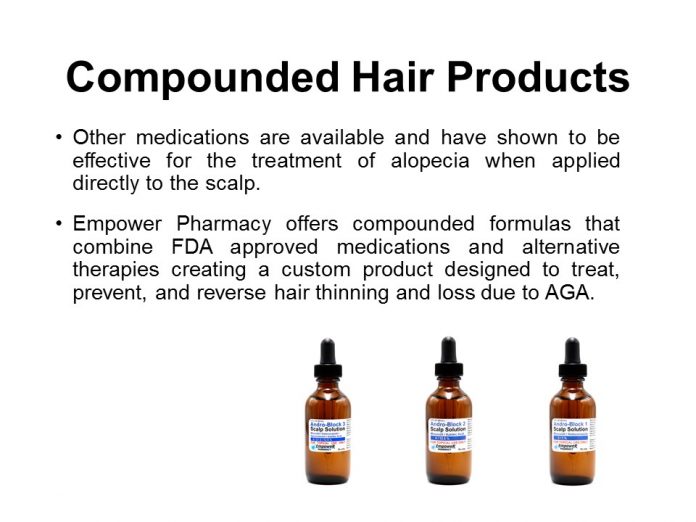Testosterone and Hair Loss: What You Need to Know
Testosterone replacement therapy (TRT) is one of the most effective methods for treating hypogonadism, erectile and sexual dysfunction. Sadly, as with any treatment, a minority of men may experience hair loss.
A small but concerning percentage of men (mostly under 45 years of age and with genetic predisposition to hair loss) undergoing TRT begin to notice that their scalp hair tends to thin drastically within 3 to 6 months of the hormone therapy. This isn’t the case with all men, and it’s still not quite clear WHY men undergoing TRT begin to lose their hair although some studies speculate that one of testosterone’s main metabolites, DHT, may exert negative effects on hair follicles. However, if you’re unlucky enough to fall into the “going bald” category, you may be wondering what to do. After all, you can’t stop the TRT, but you don’t want to have to continue to lose your hair. It’s like being caught between a rock and a hard place! What can you do?
Many men turn to Rogaine (Minoxidil) or Propecia (Finasteride) as a means of combatting hair loss. These are the two most popular anti-balding topical drugs, the ones that receive the most media attention and advertising time.
But, one thing you need to understand is that they may not be the best solution in your case. Why is that? Two words: drug interactions.
Oral Finasteride, the medical name for Propecia, is designed to block dihydrotestosterone (DHT), an androgen hormone that is believed to play a large role in hair loss. However, while it may help to combat balding, it may contribute to low sperm count, impotence, and a number of other significant (and terrible) side effects. The medication may reduce the effectiveness of the TRT, as it’s essentially blocking another form of testosterone. You may not be able to stop the hair loss, and you’ll only make your testosterone replacement therapy less effective.
If you’re looking for another solution to combat hair loss, here are a few alternatives to consider:
Rogaine
Unlike Propecia, Rogaine doesn’t come with all the negative side effects. This OTC treatment is a topical one rather than oral, so it is applied directly to the scalp as a means of combatting male pattern baldness–or, in this case, baldness as a result of the testosterone replacement therapy.
How does it work? Rogaine helps to increase the flow of blood to your scalp and hair follicles, preventing the follicles from shrinking–basically jump-starting them and getting them back into working order. The topical treatment is very unlikely to interact negatively with oral medications (or topical testosterone), so it should be fairly safe for your use.
Bonus: There are a few preparations of Rogaine that have been fortified with Propecia, which may prove even more effective at combating hair loss. The addition of finasteride can help to maintain hair density, though it’s usually only used after taking oral finasteride. However, it won’t be absorbed into your body, just directly to your scalp. Topical finasteride (Propecia) mixed with Rogaine is far less likely to cause negative side effects, and may be safe to use while on TRT. Consult your doctor before using.
Platelet-Rich Fibrin Matrix Injections
In 2014, a study was published in the journal Facial Plastic Surgery, detailing the results of using platelet-rich fibrin matrix as a means of treating hair loss.
Platelet-rich fibrin matrix (PFRM) is a mixture made by separating the red and white blood cells from the platelets and plasma. According to the Journal of the American Medical Association, ” It is collected in a vacuum-sealed collection tube with a thixotropic separator gel, and the tube is centrifuged for 6 minutes at 1100 rpm. This process separates the red and white blood cells from the plasma and platelets, which are then transferred in a closed system to a second tube containing calcium chloride; it is this small amount of calcium that initiates the fibrinogen cleavage and the fibrin polymerization.”
In the Facial Plastic Surgery study, 15 men and women with androgenetic alopecia were given injections of PFRM three times a month over the course of 1 year. During that time, their hair density indexes were monitored. After just 1 year, hair density indices increased significantly, meaning the patients’ hair grew thicker and more dense on the scalp.
For those looking to combat the hair loss resulting from TRT injections, PFRM may be a viable, safe option to consider.
Fat Stem Cell Injections
In a 2015 meeting of the ISHRS, a Spanish doctor presented clinical data regarding the use of Kerastem regenerative cells as a means of treating genetic alopecia in both men and women. The injections enriched fatty (adipose) tissue in the patients, and all 9 of the patients showed a positive response to the injections. Hair count and density improved by an average of 29% in the men with early grade hair loss, and an average of 17% for all of the subjects studied.
Latanaprost
Latanaprost is a medication used to help regrow eyelashes that have fallen out as a result of thyroid disorders or stress. However, studies have shown that the hair re-growth benefits extend beyond just the eyelashes, but the medication can even help to replenish hair that has been lost from the head.
A 2012 study published in the Journal of the American Academy of Dermatology found that latanaprost “significantly increased hair density (terminal and vellus hairs) at 24 weeks”. Essentially, it could help to stimulate activity in the hair follicles, making it a potentially effective treatment for hair loss. Best of all, there should be no negative interactions with the TRT, as it is another topical treatment.
For more information, visit: https://www.excelmale.com/content.php…eyond-Propecia












Latanoprost is used to treat high pressure inside the eye due to glaucoma (open angle type) or other eye diseases (e.g., ocular hypertension). It is similar to a natural chemical in the body (prostaglandin) and works by regulating the flow of fluid within the eye which results in lower pressure. Lowering high pressure inside the eye helps to prevent blindness.
Grow hair??
Dan Malloy,
PG aare involved in hair loss/growth. PGE2 causes hair loss and PGD2 causes hair growth-
Latanoprast acts like PGD2.